Weed, Fungus and Stress Control in Peonies
In this newsletter we discuss some current affairs in the field of peonies.
Weed Control
There are some changes in the field of weeds. Here is an overview of the most important products that are used in peonies around this period.
New product: Oblix 500 SC
Is a soil herbicide based on ethofumesate with a systemic action via the underground parts of the weeds. Has a contact effect on weeds in the germ layer. A moist soil promotes the effect. Oblix controls a broad spectrum of annual weeds. Approved as a bottom top treatment (hood sprayer) with a dosage of 0.6 l / ha. The agent may be applied twice a year.
The loss of Lentagran makes this a nice addition to the package.
Gallant 2000 – end of admission
Gallant 2000 is going to lose its authorization. The period you can still purchase it (delivery term) is June 30, 2021. The final use period is August 31, 2021. Keep this in mind if you still want to use the product. Gallant is used against grasses, including annual meadow grass. Dosage is 1 l / ha.
Lentagran – end of authorization (in floristry crops)
At the end of September, the CTGB completed the re-registration of Lentagran WP. Some crops have disappeared from the label, including floristry crops. This means that we can apply Lentagran in the peony for the last time this season. Delivery term for Lentagran WP for floristry crops, among other things, is April 2, 2021. The use-up period is September 2, 2021.
If you still want to use Lentagran this season, you must purchase it before April 2.
Goltix WG / Bettix SC
Both products are based on metamitron and have both soil and contact effect. Goltix WG is granulate and Bettix SC is liquid. Has an effect on ground herb, shepherd’s purse and chamomile, among other things.
Goltix Queen
Goltix Queen is a combination of a known active ingredient; metamitron and a new post-emergence substance; quinmerac. As a result, the effect compared to metamitron alone is stronger on, among others; goosefoot (melde), cleavers, peach herb and dog parsley. Goltix Queen provides an after-effect against weed seedlings and also a synergistic effect with other post-emergence herbicides.
Corzal SE
Corzal SE is a foliar herbicide without soil action. The agent controls annual broadleaf weeds. Preferably apply to very young weeds (germ leaf stage). Less sensitive weeds include chamomile, cleavers, pig grass, peach grass, water pepper, and rapeseed storage plants. Grasses and root weeds are not controlled. In peonies, this medicine is almost always used in combination with medicines containing metamitron.
Vivendi 100
Contains the same active ingredient as Lontrel. The product is a systemic foliar herbicide with some residual effect via the soil and has a strong effect on present thistles, butterbur, clover, bud herb, many-buds (including peach herb, pig grass) and an effect on composites and black nightshade. During certain circumstances, peonies can be sensitive and crop reaction can occur.
Advice
We compile advice in consultation with you on the basis of the weed pressure and type, time and soil type.
Basic advice for a bottom application could be a combination of the following 3 resources;
0.5 – 1.5 kg / l / ha Goltix WG or Bettix SC or Goltix Queen
0.5 – 1.5 l / ha Corzal SE
1.0 – 2.0 l / ha Oil
For all remedies with a soil action, a moist soil contributes to the success of the (longitudinal) action.
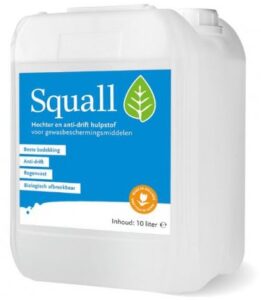 Squall
Squall
Squall has proven itself in recent years in peony cultivation, among other things. New is that Squall is allowed as a Drift Reducing Technique when injected. With a 90% cap it is then possible to spray agents that have a 95% drift reduction requirement, which does not always require a pressure registration. Squall also gives a better coverage due to the strong adhesion and improved flow. Two birds with one stone!
Mold Control
Below some products that have been changed:
AlibiFlora
This agent is 100% identical to AmistarTop. The label of AmistarTop has changed and may therefore no longer be used in peonies. Alibi Flora is available from around mid-April in 1 and 5 liter packaging. Has a good effect on botrytis and leaf spot disease. Label dosage: maximum 2 applications per year of 0.9 l / ha with a minimum interval of 7 days.
Palladium
This agent is 100% identical to Switch. Palladium is available in 5 kilo packaging. Palladium has a price-technical advantage.
Mancozeb containing agents
This year is the last year that you can still use mancozeb containing products. These include; Mastana SC, Penncozeb SC, Dithane DG and Tridex DG.
The definitive date of the sale and use up period has yet to be determined by the CTGB.
Stress and fungal control agents can be combined well in most cases. For a tailor-made schedule; contact your cultivation specialist.
Previsan
A successful way to remove the sticky sweet excretion of a peony or honeydew and thus prevent sooty mold.
In the cultivation of peonies, among other things, the flowers can under certain circumstances secrete a sticky sweet substance (resin) and sooty mold (fungus) can develop on this. In addition, aphids deposit honeydew, which can also result in sooty mold. Usually irrigation is done to prevent this. If this is not possible due to circumstances, Previsan can be an aid.
The experiences are good. In addition to preventing the sooty mold, fluffing is also a lot faster. For more information, read the product information sheet
Stress Management
The resilience of various crops, including peonies, can be increased by using StressImmune and AminoBoost.
StressImmune is a combination product of seaweed extract and amino acids. This combination gives the plant more resistance to biotic stress (heat, drought, frost, etc.). There are now many good experiences in various crops. The dosage is 1-1.5 l / ha with an interval of 10 to 14 days. If severe stress is expected (heat, frost), 2.5 liters / ha can be applied a few days before this period.
After a stress period, the plant can be supported with 2.5 l / ha AminoBoost.
This product contains many amino acids, among other things. Because the plant produces it less or more difficult due to stress, you can support the plant with it. As a result, the plant continues to grow better.
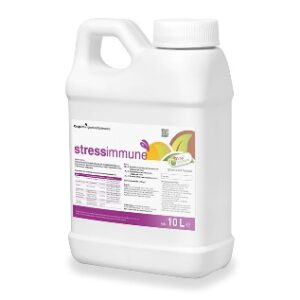
StressImmune
StressImmune can be widely used against stress. A preventive use activates the plant immune system so that diseases and pests are more strongly repelled and the vitality of a plant increases.
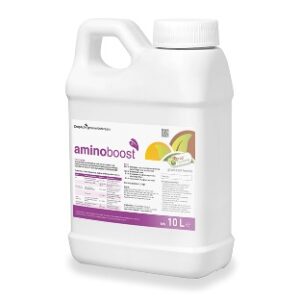
AminoBoost
The amino acids in Aminoboost accelerate the recovery of the plant after a stress period. By treating the crop in time for the ripening period, growth can be extended.
In this newsletter we will discuss some current topics considering the growth of peonies.
Crop position
The Dutch Peony Season has started late because of the cold weather. Due to these weather conditions, damage has occurred here and there which has increased the pressure of botrytis. Common remedies that can be used include Luna Sensation, Frupica and Switch/Palladium.
Peonies in greenhouses
The cultivation of peonies in greenhouses requires extra attention as compared to outdoor peonies. At CAV Agrotheek, we have gained quite some experience in this cultivation and we have seen an upward trend in crop status for three years in a row. This is mainly due to an innovative approach regarding soil balance.
Note: Do not forget to monitor the fertilization after the harvest.
Looking for more advice?
Please contact our cultivation advisor Michel de Groot.
Phytophthora increase in peonies
We are seeing an increase in problems with phytopthora in several lots. Plants that were still producing plenty last year may be completely spoiled this year. There are several reasons for this: what we currently see is the result of last year’s weather conditions.
Abundant rain after a dry, warm period encourages fungus to form swarm spores. These can infect parts of the plant. Infestation is strongest at temperatures between 20 and 30 degrees celcius. Lots or places with structural problems are extra sensitive. We encounter this particular problem in several cultivars of various ages. Since a number of days, the image of above-ground phytopthora can also be found in the crop.
Advised resources include Axidor and Ranman Top.
Meanwhile, CAV Agrotheek has started a major multi-year investigation. We will keep you posted.
Lettuce rootworm
Last week, the first empty cocoons/shells of the lettuce rootworm were found outside. Therefore, check your plots. The pressure is particularly low this year.
In recent years, many plots have been successfully treated with insect parasitic nematodes. There are also possibilities with Botanigard WP.
From experience we know that after some 3 weeks the eggs will hatch and the young caterpillars will start looking for the underground parts of the peony. This means that you can start the treatment from about week 23/24.
In both ways, the action plan is crucial to get good results.
Previsan
A successful way to remove honeydew and thus prevent sooty mold.
In the cultivation of peonies, the flowers may start to secrete honeydew under certain circumstances, which can lead to sooty mold (fungus). Fluffing is also less easy. Previsan can be the means to prevent this from happening.
Experiences are good. In addition to preventing sooty mold fungus, fluffing is also a lot faster.
Stress management
Due to the cold weather there is a lot of “stress” in the plant. The experience of supporting the plant with Aminoboost is quite good. This product contains high-quality amino acids. Because the plant produces less (or more difficult) amino acids due to stress, one can support the plant. Dosage; 2 liters per hectare. This can be used in combination with various means.
Pre-treatment agents for peonies
At auctions it is obliged to treat the peonies with the pre-treatment agent Florrissant 500N (“the chlorine pill”), or possibly the liquid version: Florissant 520. The latter is particularly suitable for use in the barrel filler equipped with a dosing installation.
Peony blades and rain suits are also available at CAV Agrotheek.
Want to know more?
For more information, please contact your cultivation specialist or the Agrotheek head office.
CAV Agrotheek CARE
Agrotheek relieves growers by means of advice and as the supplier of crop protection products, fertilizers, seeds, flower bulb nets, business supplies and various services.
Agrotheek is an established name in all sectors of agriculture and, in addition to advice, also offers a rich package of services. This way we can support you in making the right decisions throughout the growing season.
Your business return is leading in our daily actions. With Agrotheek you always have a view of a good result. With a broad team of experienced specialists, Agrotheek can help you as a grower with every cultivation.
Agrotheek CARE.
- Core values
- Strong network
- Cultivation specialists
- Nearby
- Unburdens
Stress: Amino acids provide calmness
Knowledge Item
In agriculture and horticulture one increasingly encounters the term ‘biostimulants’. For some, this application is already standard practice, for others it is still quite unknown. In recent years many new products have entered the market that contribute to a healthy and vital crop. A good example of such products are Biostimulants, which are based on ‘amino acids’. However, the great diversity of biostimulants coming onto the market make it increasingly difficult for growers and advisors to distinguish the differences between the products and their claims. Time for some explanation about amino acids as biostimulants.
What are Amino Acids?
Amino acids are the building blocks of proteins. In addition to carbon, oxygen, hydrogen and nitrogen, some amino acids also contain sulfur. Proteins (also called proteins) play a key role in almost all biological processes. Certain proteins speed up crucial steps in metabolism, and proteins also occur as signaling molecules or are involved in the transport of nutrients and organic molecules from one cell to another. In nature there are twenty different types of amino acids, whereby the specific sequence of the amino acids in a protein determines how the protein functions. A short chain of amino acids (i.e. part of a protein) is called a peptide.
The usefulness of amino acids in agriculture and horticulture
Since proteins take care of many processes in plant cells, many of the sugars and nitrogen produced by the plant are used for the production of proteins.
This production consumes a lot of energy. When a crop goes through a stressful period, for example due to a lot of precipitation or drought or cold, but also as a result of herbicide or fungicide spraying, the crop will respond to this by means of a stress response. A stress response requires a lot of new proteins, and thus also a large amount of amino acids and energy.
Research has shown that when crop is offered amino acids under the influence of stress by means of foliar spraying, it can immediately use these acids for production of proteins. As a result, the crop has to spend less energy on the stress response, which prevents growth retardation and loss of yield.
Amino acids have even more useful properties. They can act as a chelator, allowing better absorption of nutrients. Amino acids also have a flowing effect on the spray liquid. In higher doses, amino acids can serve as a natural N fertilizer.
Origin and effectiveness of amino acid products
There are major differences between the various amino acid products. The main difference is in the origin; animal or vegetable. Animal amino acids are produced from slaughterhouse or fish waste, and amino acids of vegetable origin are often sourced from soybean sprouts, corn water or other vegetable products. There are also synthetic amino acids, but these are very one-sided in composition.
In order to arrive at an amino acid product, the proteins must be reduced from the raw material to free amino acids. After all, only these free amino acids can be quickly and easily absorbed by the crop to support a stress response. The reduction of proteins to free amino acids is called hydrolysis. Vegetable proteins generally provide a higher content of free amino acids compared to animal proteins.
If you want to support the crop during stress with an amino acid product, then choose a product of vegetable origin. To promote the binding of nutrients, a product of both vegetable and animal origin can be used. In order to determine what kind of amino acid product you are dealing with, you can request the exact composition of (free) amino acids and the amino acid – peptide ratio from the supplier. This provides clarity about the composition, quality and origin of the product.
Optima Leaf-Amino
KaRo has in its assortment foliar nutrition Optima Leaf-Amino. This bio-stimulant, based on vegetable sources, has an exceptionally high content of 18% of free amino acids (total 30% amino acids).
- Dosage
1.5 ltr/ha during herbicide, fungicide or insecticide spraying reduces growth inhibition and promotes good leaf coverage. - 2 ltr/ha in abiotic stress conditions, such as cold, drought, heat or an excess of precipitation, support the crop with weekly spraying and reduce possible yield loss.
- 5 ltr/ha for a quick nitrogen fertilization, possibly in combination with urea. Optima Leaf Amino reduces leaf burn in any case after foliar spraying with a high dose of urea.
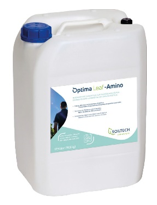
Packaging
Optima Leaf Amino is available in:
- 5 liter jerry cans
- 17.5 liter jerry cans
- 1,000 liter IBCs
Spray Tips
- Mixing with systemic fungicides and/or systemic insecticides is almost always possible.
- Aim for a ratio of foliar fertilizers and water of 1 : 100 to avoid the possibility of residue or spray damage.
- pH of the spray liquid between 5-7. It does not matter much for our foliar feeds, but it is very important for various crop protection products. If necessary, use a water conditioner or provide the sprayer with a pH control.
- Spray the crop with as fine a drop as possible to avoid residue.
- Apply to an active crop for effective absorption; temperature during spraying between 5 and 25 degrees Celsius.
- Do not apply in sunny weather due to the risk of burns.
- Correct time of spraying: very early in the morning or early evening. When spraying in the evening, keep in mind that the crop dries up less quickly and therefore has a longer leaf-wet period (which means there is a chance of getting sick and sore).
- If in doubt, contact us about your foliar application.
Balancing and nourishing the soil with Vigro ReceptMix

Because many stems have been cut and the remaining crops are then mown off and possibly removed from the plot, the soil is literally looted every year. Recovery is possible by applying a Vigro ReceptMix. The recipe is field-specific and is determined on the basis of a Soil Balance Analysis or the Eurofins Fertilization Indicator.
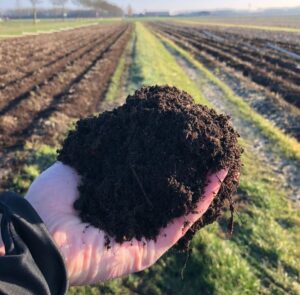
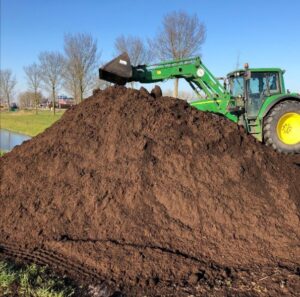
Ingredients
Vigro ReceptMix is a high-quality custom compost mixture:
• Wood compost (green compost)
• Worm humus, rich in protozoa = soil life
• Fungal humus, rich in fungi
• Compost is a nice source of potassium and makes potassium spreading unnecessary.
• Addition of necessary main elements; such as sulfur, magnesium.
• Addition of required trace elements; such as manganese, molybdenum.
Vigro ReceptMix is matured under oxygen-rich conditions and the right temperature to eliminate weed seeds and plant pathogenic diseases.
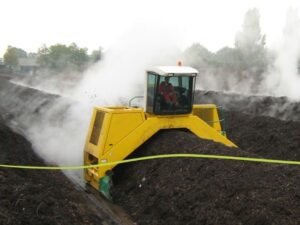

Benefits of Vigro ReceptMix
• Well able to bind positive and negative elements in contrast to clay, so less leaching of elements.
• Can buffer moisture well during heavy showers.
• Can act as a moisture buffer for the crop during a long drought.
• Contains rich diversity of fungal biology, protozoa and bacteria.
• Is ‘housing’ and food for soil life. Soil life will build up faster. Fertilizer actually breaks down soil life.
• Direct structure improving effect and also indirect effect through activity of worms that are stimulated to make corridors.
• Having a working pass by applying fertilizers and compost in one go.
• Nutrients are gradually released according to the needs of the crop.
In several fields, the applied mixture has even made the spreading fertilizers superfluous. This will prevent fertilizer from harming the soil and save on this item.
The compost can simply be applied on top of the soil in an existing crop. Also suitable for processing through the soil in new plantings. Vigro ReceptMix can be delivered in bulk, but also in big bags.
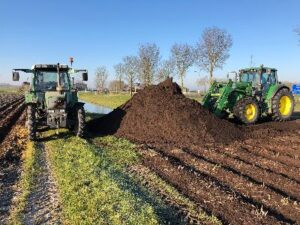
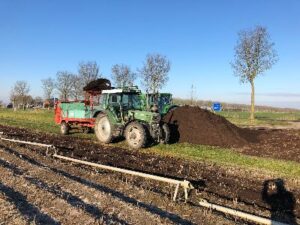
Roadmap
If you are interested in upgrading your plot using Vigro ReceptMix, the procedure is as follows:
• Take a soil sample from the plot
• Have an extensive soil analysis made
• A ReceptMix is calculated and offered to you
• If you agree, we will take care of the delivery of the compost
• A contractor -or yourself- distributes the compost evenly over the plot
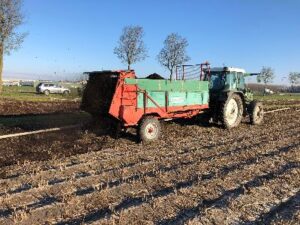
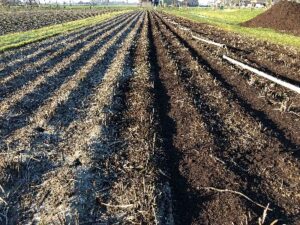
Extensive product information about the different mixtures, photos and videos of the application can be found in our webshop at the crop peony.
For more information, please contact:
Marco Culurgioni
mc@karobv.nl
+31 06-86823006
Danny Rood
dr@karobv.nl
+31 06-51147142
;)
